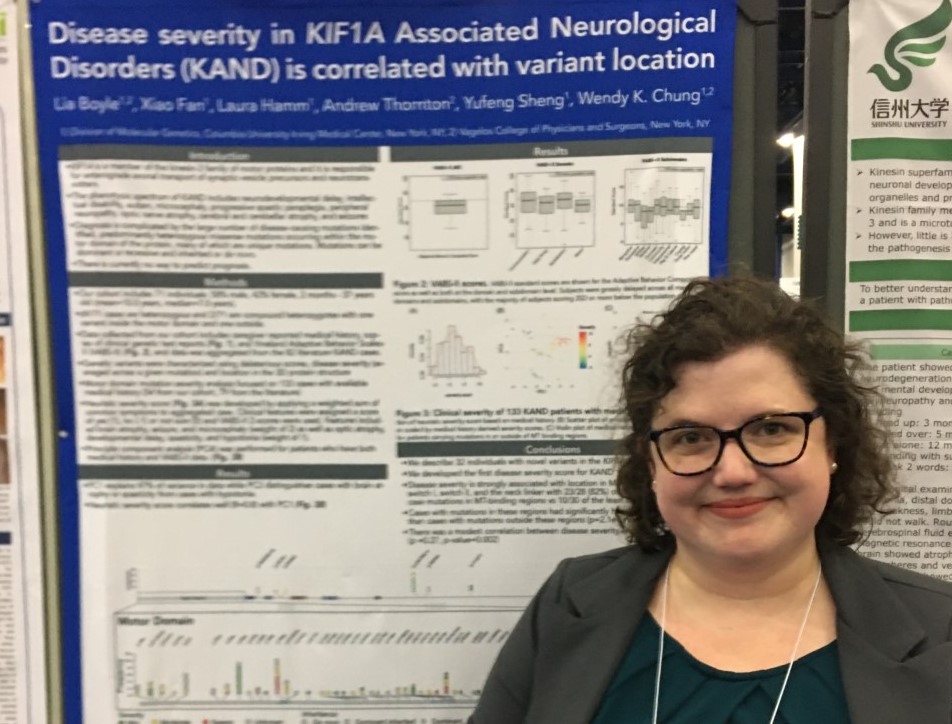#ScienceSaturday posts share relevant and exciting scientific news with the KAND community, and are compiled by Alejandro Doval. Alejandro is from Spain and serves as Team Leader of the KIF1A.ORG parent-led Research Engagement Team. Send news suggestions to our team at impact@kif1a.org.
Recent KIF1A-Related Research
Disease Severity in KIF1A Associated Neurological Disorders (KAND) Is Correlated with Variant Location
This research was shared in a poster presentation by Lia Boyle, a researcher at Chung Lab and member of the KIF1A.ORG Research Team, at the American Society of Human Genetics (ASHG) Annual Meeting on October 17. This analysis helps us understand how KIF1A variants relate to the range of symptoms and severity we see in KAND. Much of the data in this publication came from the world’s only KIF1A Natural History Study, funded by KIF1A.ORG.

Additional KIF1A Research Presented at ASHG
Two other KIF1A-related posters were presented at ASHG. Here are the summaries that are currently available.
Kinesinopathies: Emerging Role in Genetically Undiagnosed Rett Syndrome
Adding to research we shared last week connecting Rett Syndrome (RTT) to KIF1A, researchers from Murdoch Children’s Research Institute in Australia and other institutions presented their research that identified KIF1A mutations in undiagnosed RTT/RTT-like patients. From their findings: “There is an unmet need to provide a precise genetic diagnosis for these patients.”
Clinical Features of KIF1A-Related Disorder: A Japanese Patient with a Novel Missense Variant and Literature Review
This detailed study of a 33-year-old man diagnosed with a KIF1A-Related Disorder (aka KIF1A Associated Neurological Disorder or KAND) describes symptoms commonly associated with KAND and concludes: “Molecular genetic analysis of KIF1A should be considered in patients who show a combined phenotype of both upper and lower neuron sign, intellectual disability and cerebellar ataxia.”
Rare Disease News
Overcoming the Blood-Brain-Barrier: Delivering Therapeutics to the Brain
In a story from Newcastle University: “For the first time, scientists have identified a simple way to effectively transport medication into the brain—which could lead to improved treatments for neurological and neurodegenerative diseases.” One of the major challenges of treating neurodegenerative diseases is getting treatment into the brain. Researchers call this a “major breakthrough” with 10 years of research behind it.
Stem Cell Transplant Reverses Disabling MS-like Disease
A stem cell transplant reversed a debilitating neurological disease that causes half of the patients to go blind and lose the ability to walk five years after diagnosis. This is an exciting example of a successful approach to treatment for neurodegenerative disease vía stem cells.
Functional Outcomes of Cerebellar Malformations
“The cerebellum has traditionally been regarded solely as a regulator of motor function. Regardless of the condition, there is a growing consensus that developmental disturbances of the cerebellum may be a central culprit in triggering a number of distinct pathophysiological processes. We highlight growing concerns that neurological and neuropsychiatric diseases with severe behavioral outcomes originate from developmental insults to the cerebellum.”
This paper sheds light on the complex role of the cerebellum in neurodegenerative diseases. Cerebellar atrophy is a known concern with KAND. Could cerebellar atrophy associated with KAND cause not just motor challenges like ataxia and tremors, but also symptoms like autism and anxiety?

